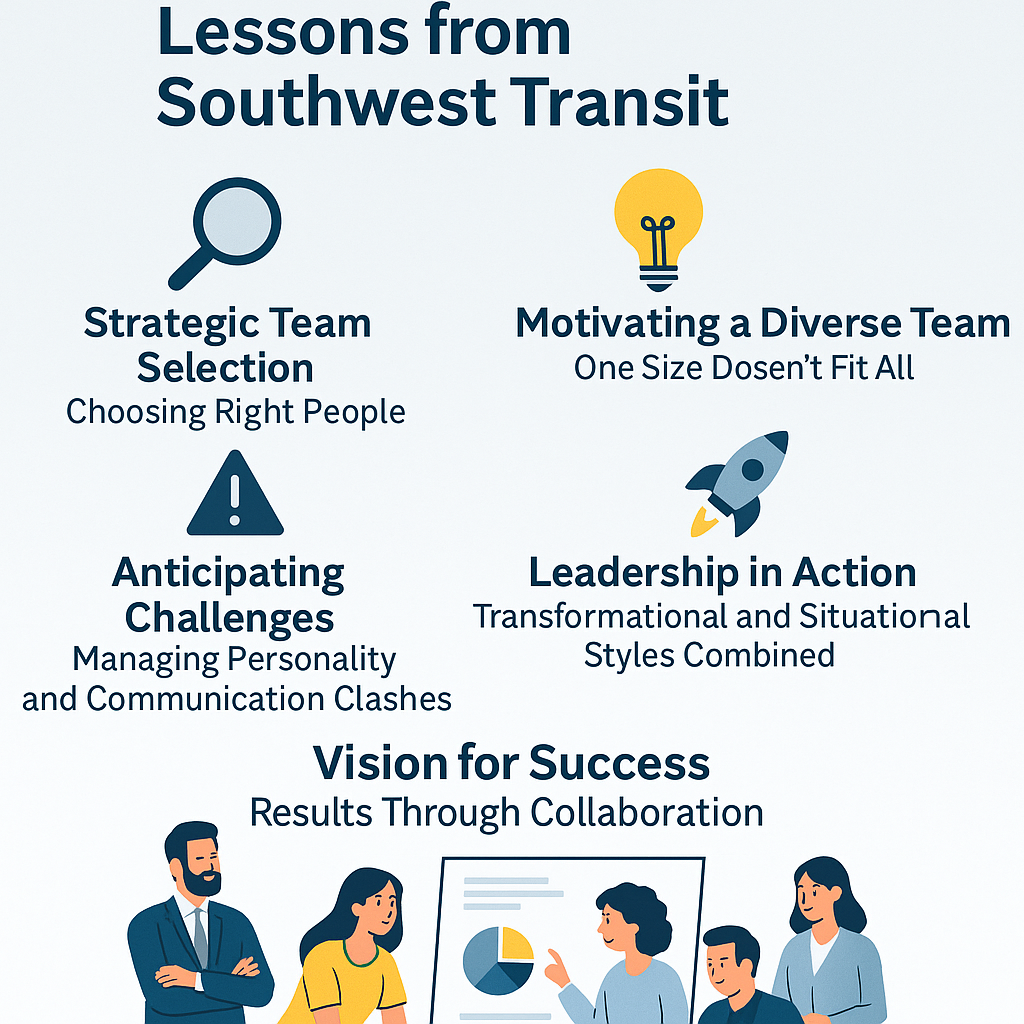Southwest Transit Case Study.
Conscious Capitalism, Grand Canyon University, Leadership, Master's in Business Administration, Organizational Management Conscious Capitalism, Grand Canyon University, Leadership, Management, Master's in Business Administration, MBA, organizational behaviorSouthwest Transit Case Study
In today’s fast-moving market, companies must act quickly and wisely to stay competitive. Southwest Transit faced this challenge head-on when a major competitor launched an aggressive campaign—just as the company was preparing to unveil its new Boeing 747. With only six weeks to deliver a high-impact marketing campaign, leadership had to quickly build and motivate a high-performing team.
Here’s how they did it—and how you can apply the same strategies to lead your team through pressure-filled projects.
Meet the People Behind Southwest Transit
At Southwest Transit, success starts with the people behind the scenes. From running routes to training new staff, every team member plays a key role. Let’s meet the individuals who keep things moving.
Carl Carson
With 16 years at the company, Carl is the calm in any storm. He leads quietly but effectively, offering consistency when it matters most. People count on him.
Strengths: Steady leadership, institutional knowledge, fairness
Opportunity: Engage more with the team to build stronger connections
Tracy Schmidt
Tracy brings over 20 years of energy, structure, and high standards. Her sharp eye for detail keeps the team on track, though it can sometimes feel intense.
Strengths: Organized, experienced, driven
Opportunity: Give team members more space when possible
Matt Brantley
Matt’s upbeat and approachable nature makes him a go-to for coworkers. He’s a strong communicator who brings both humor and guidance.
Strengths: Friendly, clear communicator, great trainer
Opportunity: Show more authority in leadership moments
Adam Stokes
Adam is dependable and calm, always ready to lend a hand. He’s thoughtful and quiet, but sometimes hesitates in fast-moving situations.
Strengths: Reliable, supportive, composed
Opportunity: Be more assertive when quick decisions are needed
Linda Rojas
Linda runs a tight ship with professionalism and pride. She’s sharp, experienced, and expects the same excellence from others.
Strengths: Skilled, reliable, takes ownership
Opportunity: Be more open to change to ease transitions
Joe Martinez
Joe is the team’s spirit booster. Friendly and upbeat, he connects with riders and coworkers alike. But he sometimes overlooks small policy details.
Strengths: Positive, personable, strong morale-builder
Opportunity: Improve consistency with procedures
Amanda Lee
As the newest team member, Amanda is learning the ropes quickly. With past experience and a great attitude, she’s already showing promise.
Strengths: Motivated, experienced, eager to learn
Opportunity: Build confidence and rapport over time
🔍 Strategic Team Selection: Choosing the Right People
Picking the right people is the foundation of any successful project. Southwest Transit chose six standout team members:
Natalie – A bold, challenge-ready leader
Elizabeth – Positive, experienced, detail-oriented
Katelyn – High-performing under pressure
Doug – Bonus-driven and deadline-focused
William – Collaborative and emotionally intelligent
Ian – Tech-savvy and creative
Leaders intentionally passed over candidates who lacked motivation or had poor track records—reinforcing that the right fit matters as much as skill.
💡 Motivating a Diverse Team: One Size Doesn’t Fit All
Motivation theory played a key role. The team used Herzberg’s Two-Factor Theory, which focuses on:
Motivators: Achievement, growth, responsibility
Hygiene factors: Already covered within company policies
Still, Herzberg’s model doesn’t address individual differences. So leaders used tailored strategies:
High achievers got stretch goals
Doug received bonus incentives
Self-starters like Ian and Katelyn were trusted with autonomy
✅ Takeaway: Motivation is personal. Leaders must understand what drives each individual.
⚠️ Preventing Conflict: Communication and Personality Clashes
Every team faces friction. With different personalities and styles, conflicts can easily arise. For example:
Natalie and Katelyn’s fast pace could overwhelm slower, more methodical teammates like Doug or Elizabeth.
To manage this, leadership used:
The Interest-Based Relational (IBR) approach for respectful conflict resolution
Regular check-ins to keep communication open
Team-building workshops to foster understanding
🚀 Leadership in Action: Adapting Styles for Success
Leaders combined two proven styles:
Transformational Leadership – Inspiring creativity and shared vision
Situational Leadership – Adjusting style to match each team member’s needs
For instance:
Natalie and Elizabeth thrived under a hands-off approach
Newer members received more guidance and coaching
🔑 Key Insight: Great leaders know when to delegate—and when to step in.
🌟 Vision and Results: Winning Through Collaboration
The team shared a simple but powerful vision:
To become a resilient, innovative unit that delivers results under pressure.
With a mix of motivation, skill, and strong leadership, the team not only met expectations—they exceeded them.
✅ Final Thoughts: What You Can Do
No matter your industry, these strategies work:
Choose the right people
Tailor motivation to each team member
Use proven theories, but personalize your approach
Address conflict early and empathetically
Adjust leadership styles based on the situation
Inspire with a shared vision
💬 What’s your biggest challenge when building or motivating a team? Share your thoughts in the comments.
